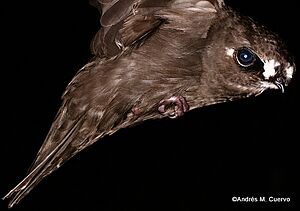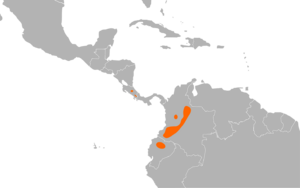Spot-fronted swift facts for kids
Quick facts for kids Spot-fronted swift |
|
|---|---|
 |
|
| Conservation status | |
| Scientific classification | |
| Genus: |
Cypseloides
|
| Species: |
cherriei
|
 |
|
The spot-fronted swift (Cypseloides cherriei) is a cool bird that belongs to the swift family, called Apodidae. These birds are known for their amazing flying skills. You can find them in several countries like Colombia, Costa Rica, Ecuador, Panama, Peru, and Venezuela.
Contents
About the Spot-Fronted Swift
What Does a Spot-Fronted Swift Look Like?
The spot-fronted swift is about 14 cm (5.5 in) long. That's about the length of a regular pencil! It weighs around 23 g (0.81 oz), which is lighter than a few quarters. Both male and female swifts look the same. They are mostly dark brownish-black. Their underwings look a bit grayish, and they have a white chin.
They get their name from two bright white spots. These spots are found on each side of their beak and behind their eyes.
Where Do Spot-Fronted Swifts Live?
Spot-fronted swifts are found in different places across Central and South America. They live in montane forests, which are forests found in mountains. You can usually find them at heights between 1,100 and 2,200 m (3,600 and 7,200 ft) above sea level. Sometimes, they have been seen as low as 300 m (980 ft) in Ecuador.
In Costa Rica, they are mostly found on the Pacific side of the Central Mountain Range and the Cordillera de Talamanca. They are known from only a few spots in Panama. In Colombia and Ecuador, they are found in more places, but these spots are still far apart. They are rarely seen in western Venezuela or northern Peru.
Spot-Fronted Swift Behavior
How Do Spot-Fronted Swifts Find Food?
Like all swifts, the spot-fronted swift catches insects while flying. They are called "aerial insectivores." This means they eat bugs right out of the air! One study found that they mostly eat Hemiptera (true bugs) and Hymenoptera (like bees, wasps, and ants).
Sometimes, groups of up to 50 swifts will fly together to hunt for food. They might even join other types of swifts while foraging.
Reproduction and Life Cycle
The spot-fronted swift's nesting season can be from April to July. The exact timing can change depending on where they live. They build a cup-shaped nest. This nest is made of moss, ferns, and mud. They usually place their nests on a vertical rock face, often near or even right above water.
A female swift lays only one egg. In a study done in Costa Rica, the egg hatched after 26 to 28 days. The young swift then stayed in the nest for 65 to 70 days before it was ready to fly on its own.
What Do Spot-Fronted Swifts Sound Like?
The sound a spot-fronted swift makes while flying has been compared to a laser gun! People have described it as "chirr chi-t-t-ti chirr."
Spot-Fronted Swift Status
The IUCN (International Union for Conservation of Nature) has listed the spot-fronted swift as "Data Deficient." This means we don't have enough information about them. We don't know exactly how many there are or if their numbers are changing. However, scientists believe their population is currently stable.


